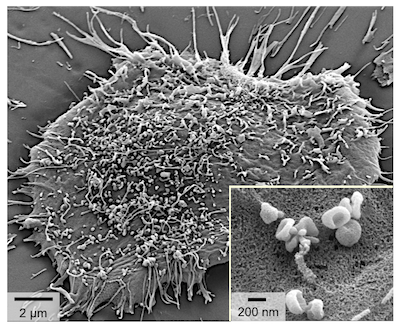The magic of “cell dust”
A novel diagnostic platform has been shown capable of detecting minuscule cell particles, known as microvesicles, in a drop of blood. These microvesicles are shed in large numbers and share the same surface markers as their parent cell. Cancer cells shed many more microvesicles than normal cells, and thus detecting them could prove a simple means for diagnosing cancer. In a groundbreaking study, published in Nature Medicine, investigators at the Center for Systems Biology (CSB) now demonstrate that by using nanotechnology together with nuclear magnetic resonance (NMR), microvesicles shed by brain cancer cells can be reliably detected in human blood.

“About 30 or 40 years ago, people noticed there was something in the blood stream and initially thought it was some debris or ‘cell dust’,”explains Hakho Lee, Assistant Professor at the CSB, and co-senior author of the study with Ralph Weissleder, Director of the CSB. “But it has recently become apparent that these vesicles actually harbor the same biomarkers as their parent cell”.
To date, circulating tumor cells (CTCs) have been held up as the potential key to cancer diagnosis. “The problem with CTCs,” explains Lee, “is that they are extremely rare so finding them in the blood is like trying to find a needle in a haystack.” Microvesicles on the other hand are abundant in the circulation. In addition, unlike CTCs, microvesicles are also small enough to cross the blood/brain barrier, which means that they can even be used to detect and monitor brain cancers.
Glioblastoma multiforme (GBM) is the most common and most aggressive brain cancer in humans. By the time it is diagnosed, patients typically have less than 15 months to live. One of the biggest challenges with this condition is accurate disease monitoring over time to establish whether patients are responding to treatment. Currently, the only way to diagnose and monitor GBM is to perform biopsies and imaging tests. Thus, longitudinal analyses are difficult, invasive and impractical. To address this need, the CSB team sought to develop a simple blood test that could be used as an easy means to monitor disease progression.

“The issue with microvesicles, however, is that they are very small so there are not many technologies out there that can detect and molecularly profile them,” explains Lee. “That is where our new technology comes in.” Using nanotechnology to target microvesicles, and by adapting and improving a novel NMR technology—previously used in the lab for cancer cell detection—the researchers were able to reliably detect microvesicles both in specially engineered mice bearing human GBM tumors as well as eventually in GBM patient samples.
Compared with other gold standard techniques, this new technology platform demonstrated excellent detection accuracy. However, unlike other methods—which can be time-consuming, require much greater sample volumes as well as expertise to perform—NMR detection is quick and simple. Indeed, using just a small blood sample, it could easily be performed in a doctor’s office with almost instant results.
“These microvesicles were found to be a remarkably reliable biomarker,” confirms Weissleder. “They are very stable and abundant.” It also appears that they are extremely sensitive to treatment effects. “We saw that we can monitor changes in the amount of these cancer-related microvesicles in the blood stream with treatment,” explains Weissleder. “Even before there was an appreciable change seen with imaging, we saw a decrease in the microvesicles. It’s like they are a harbinger of treatment response.”
The team is currently extending this platform to other types of cancer and also to other diseases such as bacterial infection.
Written by Yvonna Fisher-Jeffes, PhD
Shao H, Chung J, Balaj L, Charest A, Bigner DD, Carter BS, Hochberg FH, Breakefield XO, Weissleder R, Lee H
Protein typing of circulating microvesicles allows real-time monitoring of glioblastoma therapy
Nature Med. 2012;18(12):1835-1840 – PMID: 23142818 – PMCID: PMC3518564
Press Coverage
Mass General Hospital – Detection, analysis of ‘cell dust’ may allow diagnosis, monitoring of brain cancer (pdf)
BBC – Blood test ‘finds brain tumours’ (pdf)
Yahoo News – Test ‘could aid cancer detection’ (pdf)
Harvard Health Letter – Can we detect cancer earlier?(pdf)
Nature Medicine Podcast – Report starts at 12:40